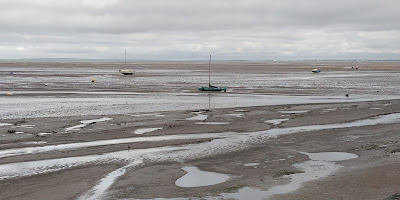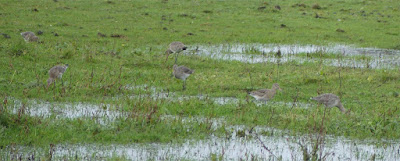 |
| Shelducks, Meols |
The morning trains were behaving themselves today so I had the trip out to the Wirral I'd planned for yesterday. The aim being to look out for turnstones, ringed plovers and any other waders I've not seen lately and particularly to try and find some black-tailed godwits as I've not seen any on the Wirral this year which is unusual.
 |
| Joining Meols Promenade by the lifeboat station |
It was threatening to be a sunny day when I set off but it was pouring down as we passed through Widnes. As I got off the train at Manor Road and walked down to the lifeboat station it was a gloomy grey day with a surprisingly mild breeze.
 |
| Shelduck, Hoylake |
It was a couple of hours after high tide so there was a great stretch of wet muddy sand punctuated here and there with curlews, redshanks and shelducks before the distant lines of tideline cormorants and great black-backs. Closer by redshanks, mallards and shelducks dodged in and out of the stretches of wet marram and sea plantain while linnets and pied wagtails rummaged around in deep cover.
 |
| Little egret, Hoylake |
A few little egrets shrimped on the pools by the seawall. Every so often a passing dog would get giddy and make chase, the egrets would bark raucously as they took flight, land a few yards to the side and return immediately the dog was on its way.
 |
| Shelducks, Hoylake |
Beyond the marram a few dunlins skittered about on the mud and a couple of grey plovers, hunchbacked, slowly stalked about and snapped at shrimps and passing flies.
Walking down the promenade the marram gave way to muddy sand and samphire. Small groups of shelducks came closer to the seawall while knots and oystercatchers joined the redshanks further out. I still hadn't seen any ringed plovers though. A flock of small plovers flew past but they were all dunlins. They headed for Hoylake, I carried on walking into Meols.
 |
| By Meols Promenade |
The mud and meandering creeks and rills of Meols beach were littered with oystercatchers, redshanks and loafing herring gulls. Small groups of shelducks dabbled in the wet mud, curlews stalked alone and contorted themselves as they battled to dig ragworms out of their tunnels.
 |
| Rock pipit, Meols |
A quick call and a passing dark shape turned out to be a rock pipit which landed on the algae-strewn seawall and ducked its head down every time the camera got it in focus. They know, you know. I don't know why but I'm always slightly surprised by how big rock pipits are, and how dark.
 |
| Turnstones, Meols |
I joined the revetment and walked down to the groyne. Black-headed gulls called noisily from the pools at the foot of the wall and turnstones rummaged about in the stranded seaweed.
Beyond the groyne a couple of herons and some cormorants fished the deeper pools, herring gulls and lesser black-backs loafed on sandbanks and black-headed gulls generally fussed about.
 |
| Leasowe Common, Leasowe Lighthouse on the left |
I left the revetment and dropped down onto Leasowe Common as patches of blue sky showed themselves and the sun threatened to come out. I dallied with the idea of taking the muddy track into the trees but elected to stay on the metalled path and keep my ears open. Robins, wrens and goldfinches skittered about and a couple of meadow pipits flew overhead but it was pretty quiet overall.
I turned onto the path that passes by the pond. There was no sign of the usual moorhens and even though it was so mild it was evidently too dull even for common darters to be out. A flock of goldfinches bounced about in the treetops by the horse paddocks and a great spotted woodpecker called from a big tree over the other side.
 |
| Chiffchaff, Leasowe Common |
I let on to another birdwatcher as we crossed along the path through the trees by the paddocks. He'd been watching a goldcrest in the willows further up. As I walked on I kept an eye out for any warblers. A flash of white wing stripe in a sycamore tree caught my eye found me a small flock of chaffinches. It soon became apparent they were part of a larger mixed flock: blue tits, long-tailed tits and goldfinches were busy and conspicuous, great tits and goldcrests more self-effacing. A chiffchaff bounded up and fed in the branches just overhead. The Cetti's warbler I'd hoped to hear when I walked past the pond decided to have a bit of a sing now I was fifty yards away. A couple of blackbirds came up to see what I was about and decided I was of no consequence; a dunnock decided it was time I was on my way. After a minute or two I decided to take the hint.
 |
| Black-tailed godwits, Kerr's Field |
I found the godwits I'd been missing at Kerr's Field. In their Winter greys they sorted of melted into the vivid greens of the wet grass and were surprisingly difficult to see. The oystercatchers, pied wagtails and curlews in the field were a bit more conspicuous.
 |
| Curlew and black-tailed godwit, Kerr's Field |
Over on the far side of the field a couple of wigeon, the drake in ginger eclipse plumage, grazed amongst the mallards in a deep puddle.
I walked up to Moreton Station and wondered if I had the time and energy to move on to another site. I decided I hadn't, I'd walked the stiffness out of the joints but not the aches and there was no point in spoiling an excellent afternoon's birdwatching. I might have felt differently had the sun not retreated behind a thick blanket of cloud.
 |
| Kerr's Field |

No comments:
Post a Comment